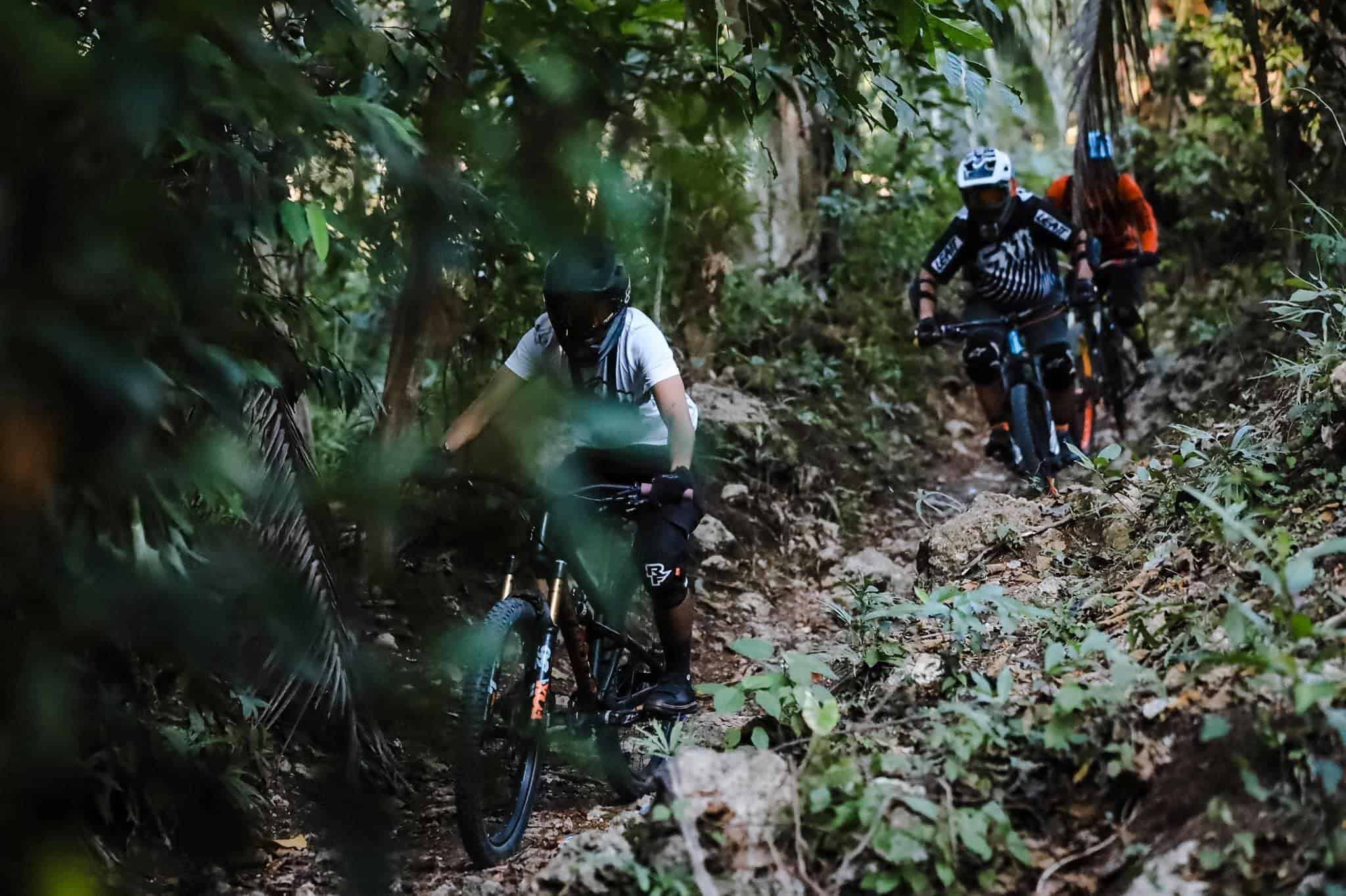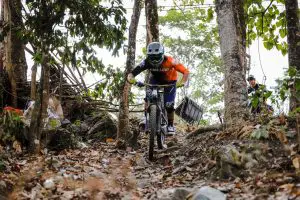Last Updated on April 20, 2022
Mountain biking is all about riding your bike in the mountains.
But what if you don’t want to travel just to ride your bike on the nearest mountain? That’s where backyard mountain bike trails come in.
In this article, we’re going to teach you how to make a mountain bike train in your backyard. No longer do you have to spend hours just to reach the trails. This will save you a lot of time and energy, while also speeding up the development of your riding skills.
It might sound easy, but building one takes a lot of planning. You also need to have the right tools and techniques. And learn the different trail features your backyard trail must-have.
Things You Need to Prepare
Building a backyard mountain bike trail is challenging. But you can make the process easier by preparing these tools and objects:
- Drill
- Saw
- Shovel
- Ax
- Rake
- Clippers
- Screws or nails
- Wood
- Dirt
Step-by-step Guide on How to Build a Mountain Bike Trail In Your Backyard
Step 1: Find a location
The first thing to do is to look for a pleasant location. You’re lucky if your house is in the mountains or if you have a huge natural backyard. Finding the right location means that it should be accessible. It shouldn’t be over 10 or 15 minutes away from your home.
This is also the time when you need to decide on what kind of backyard trail you are building. Are you going to have a flow trail? Or a more technical one? Make sure that the location doesn’t have lots of trees, vegetation, or rocks if you choose the former.
Meadows and sloping farm fields are excellent examples. You must then secure rock sections and roots if you prefer technical trails on your rock garden.
Having a rock garden with personalized content like the ones in the Sugar Creek Greenway trail will test out your technical skills crucial for racing. We usually find these in off-cambers, ridges, dense forests, and swamps.
However, the Sugar Creek Greenway trails are more natural and lack bike park-style features such as a dirt kicker and poo tracks which neighborhood kids love to ride in their own backyard.
Step 2: Outline the trail
Sketch a raw map of the trail once you’re done scouting the area. A simple sketch will do. Just outline the planned routes and show the feature you want to put. Then go for a walk on the trails and mark tape on the sides so you’ll find it easier to cultivate them later.
Ask yourself if you can climb that uphill or if the turn is too sharp to take. You can also assess if you won’t crash once you hit the planned drops or jumps. Re-route the trail if you think there’s a better way.
Step 3: Set up the foundations
Now is the time to bring out all the tools. The most important ones are the shovel, saw, clippers, and weed eaters. Call your friends to help you out because you’re surely going to need loads of muscle power. After all, they can also ride the trail later!
Use your weed eater to clean the trail routes and make them passable. You can then use the handsaw to cut the outgrown branches, twigs, and stems that you might hit when riding. The shovel is then used to dig out berms and build jumps and drops.
Note that the trail includes the whole track, so make sure you cover all of it with enough trees to gain enough speed when riding.
This is crucial for mountain bikers who want to fully utilize a back yard dirt trail. If you see minor erosions, then that’s a sign you need to further toughen up the foundation. As you’re adding support, watch out for any sign of more erosion so you can add up more ground course on the access fill area.
This is the time when you can do trial and error because you’re still building the initial base of the trail. It’s all about clearing the trail, making it passable, and setting up the features for now.
Step 4: Build the backyard trail
This is where the fun time starts. You have already cleared out the trails, right? Now is then the time to assess the trail and look for areas that might erode. The sections most susceptible to erosion are berms, jumps, and corners.
Build canals or small tunnels where accumulated rainwater can leave the trail. This is important so that there won’t be puddles. Also, make sure that the trail is slightly slanted so the gravity can pull any water or mud down and out.
It’s best if you dig at the highest part and slowly make your way down the bottom section. Also, level out the lower section by removing the dirt. This can serve as your receiver if you’d want to build jumps before it later.
Don’t force adding a certain section of the trail if you think the rain will erode it. Or if it’s beyond your skill set or comfort levels. You want to enjoy your ride safely, right? Dig small trenches on the sides or corners, so they won’t erode or lose their shape whenever you ride during the rain.
These features are enough to keep the dirt and other features intact and still made for speed despite the varying weather changes.
The trail should maintain its curved shape so you can smoothly transition your way through them later. Add logs or small wooden beams to support the corner’s foundation. You can also add an artificial jump ramp on top to serve as a kicker.
You can also add flat sections if you want to repurpose this into a cross-country trail later on for your beginner mountain biking friends. Or maybe turn it into a dirt jump backyard track so your more advanced buddies can have more fun.
Just be sure that the features allow them to gain more speed and momentum without compromising safety whenever they jump. You can do this by adding a sign and arrows made from logs so riders can gain more confidence in their ride and dirt line features.
Step 5: Add the trail features
Adding features to your trail makes your ride more fun. The features you can add are jumps, drops, berms, and North Shores. Jumps and drops are similar. But jumps have a more tilted shape because they’re meant to slingshot you to the air.
Meanwhile, drops are merely sliced up chunks of land which gives you air time once you drop off it. You can build jumps and drops by piling soil in a certain area. There are two types of jumps. These are tabletops and gap jumps.
Tabletops are a mound of soil that is formed like a small mountain. There are some ready-made tabletop jumps you can buy on the market.
Gap jumps, which are also called an OG jump line, are shaped like a half triangle. There should be two of these jump lines. The first one is where your bike takes off, and the second one is where you land. We also call this the receiver.
Berms are like corners, but they’re meant to make you faster when hitting line corners because you don’t have to brake when hitting them.
These can go to the left or right loop sections. North Shores are narrow bridges in the trail. You can even add small water treatment plant web features near the trail so that the tracks won’t dry up and erode during summer.
Finishing Your Back Yard Mountain Bike Trail

And you’re done when you’ve finished doing all these steps! But you don’t rush and ride the trail because you can damage it.
Instead, water the top layer of your back yard trail using a hose that is connected to an outdoor faucet. Regularly sprinkle water on the trails to harden the soil. You can do this for 2 to 3 days. You can then ride back on the trail after.
Conclusion
Knowing how to make a mountain bike trail in your backyard is important. It’s a great way to build up your riding skills and gain more confidence in the track and trails. It also makes it more convenient for you because you don’t have to exert loads of effort and spend lots of time to reach the trail.
Simply hop out of your house and you’re there.
Related resources:
